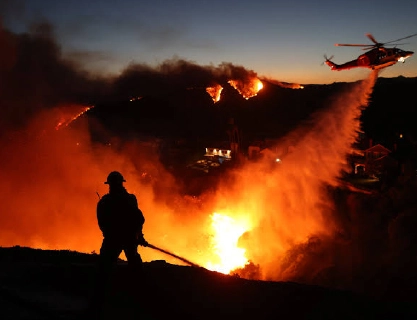Natali Rai
The start of 2025 has brought devastation to Los Angeles County as severe wildfires continue to rage across the region. Fuelled by extreme weather conditions, persistent drought, and powerful winds, the fires have forced mass evacuations, destroyed thousands of structures, and strained emergency services to their limits.
As thousands of firefighters battle to contain the infernos, the destruction continues to spread, leaving a trail of devastation and despair.
The most severe of these fires, the Palisades Fire, has scorched over 19,000 acres in the Pacific Palisades area, prompting mass evacuations and destroying countless homes. In Altadena, the Eaton Fire has consumed 14,000 acres, leaving a similar path of destruction in its wake. Smaller yet equally dangerous blazes, such as the Hurst Fire in San Fernando and the Lidia Fire in Acton, have forced localised evacuations and stretched emergency services to their limits.
The human cost of these fires is staggering. At least ten lives have been lost, and authorities fear the death toll may rise as rescue operations continue. Nearly 180,000 people have been evacuated from their homes, many of whom are now relying on overcrowded shelters for safety and support. The fires have destroyed more than 10,000 structures, leaving families without homes and communities grappling with immense losses.
Several factors have contributed to the unprecedented severity of this wildfire season. The powerful Santa Ana winds, with gusts reaching up to 84 miles per hour, have driven the flames across the parched landscape with frightening speed. Southern California is also in the grip of one of the driest starts to the rainy season on record, leaving vegetation brittle and highly combustible. Adding to this is the long-term impact of climate change, which has intensified drought conditions, increased temperatures, and created volatile weather patterns that make wildfires more frequent and destructive.
The impact on infrastructure and daily life has been profound. Power outages have left over 900,000 residents in the dark, as utility companies preemptively cut electricity to reduce the risk of further ignitions. Entire neighbourhoods have been reduced to ashes, and communities are struggling to cope with the loss of homes, schools, and businesses. Many of the displaced residents have turned to relief efforts and fundraising campaigns to provide immediate support to those in need.
Firefighters are working tirelessly to contain the blazes, with more than 1,400 personnel deployed to the frontlines. Their efforts, however, are hampered by the relentless winds and dry conditions, which have made firefighting operations particularly challenging. The federal government has stepped in to declare the situation a major disaster, providing additional resources and support to aid the state’s response efforts.
As the fires rage on, weather conditions offer little reprieve. While Los Angeles has been experiencing unusually cold nights, the dry and windy environment continues to fan the flames. With no rain in the immediate forecast, firefighters and residents alike must brace for the possibility of further destruction.
The scale of this disaster underscores the urgent need for preparedness and vigilance. Residents in affected areas have been urged to follow evacuation orders without delay to ensure their safety. Those who remain in nearby regions must take precautions to protect themselves from the harmful effects of smoke, such as wearing masks and using air purifiers. It is also critical for everyone to stay informed, relying on updates from local authorities and news outlets for information about fire progression, evacuation routes, and shelter availability.
Costliest Natural Calamity
The 2025 LA fires are a sobering reminder of the challenges posed by climate change and urban development in fire prone regions. The resilience of the affected communities and the dedication of first responders offer hope amidst the devastation, but the road to recovery will undoubtedly be long and difficult. For now, as the flames continue to spread, the priority remains ensuring the safety of those in harm’s way and providing support to the thousands of people whose lives have been upended by this unfolding crisis.
The recent wildfires in Los Angeles have also inflicted unprecedented financial damage, with total economic losses estimated between $50 billion and $150 billion.
This staggering figure encompasses property destruction, business interruptions, and the extensive costs associated with emergency response and recovery efforts.
Insurance companies are poised to bear a substantial portion of these losses. Analysts project that insured losses could exceed $20 billion, potentially setting a new record for wildfire-related insurance claims in U.S. history. This surpasses the previous record of $12.5 billion in insured damages from the 2018 Camp Fire.
The financial burden is expected to be particularly heavy for major insurers such as Allstate Corp., Chubb Ltd., and Travelers Cos. Inc. Chubb Ltd., which specialises in high-net-worth policies in affluent neighbourhoods, may face heightened exposure due to the concentration of high-value properties in the affected areas.
Beyond immediate financial losses, these wildfires are likely to exacerbate existing challenges within California’s insurance market. The state has been grappling with an insurance crisis, characterised by rising premiums and reduced availability of coverage in high-risk areas. The recent fires may intensify these issues, leading to further increases in insurance costs and a potential decrease in the availability of fire insurance for homeowners.
In response to the escalating crisis, state officials and insurance regulators may need to implement measures to stabilise the market. This could include policy reforms aimed at balancing the financial viability of insurance providers with the necessity of ensuring accessible and affordable coverage for residents in wildfire-prone regions.
The full financial impact of the Los Angeles wildfires will become clearer as damage assessments continue and insurance claims are processed. However, it is evident that the economic repercussions are profound, with significant implications for both the insurance industry and the broader Californian economy.






